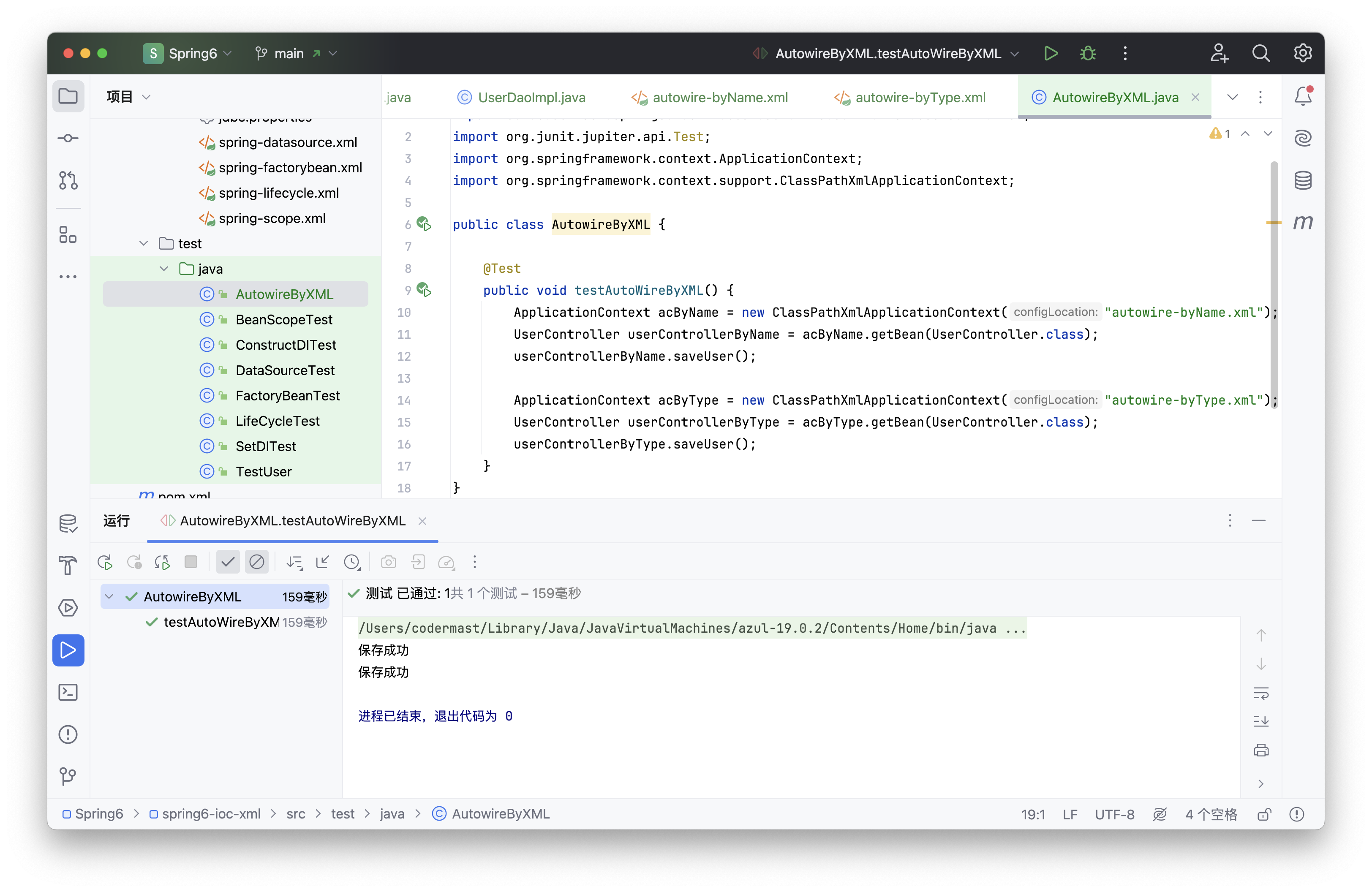Spring - 基于XML管理Bean
Spring - 基于XML管理Bean
创建子模块
在使用 XML 管理 Bean 之前,为了防止和之前的项目冲突,我们重新创建一个子模块,叫做 spring6-ioc-xml ,并且引入 beans.xml 文件即可。
获取bean
在通过 xml 方式获取 bean 之前,我们需要先导入对应的配置文件,这里我们是 beans.xml。构建 ApplicationContext 容器。
// 导入 bean 的 xml 配置文件
ApplicationContext context = new ClassPathXmlApplicationContext("beans.xml");在 xml 方式下获取 bean 对象的方式有三种:
- 根据 id 获取
// 1.根据 id 获取对象
User user1 = (User) context.getBean("user");
// 调用 user 对象的 run 方法
user1.run();
System.out.println("1 根据 id 获取的 User 对象" + user1);- 根据 Class 获取
// 2.根据类型获取对象
User user2 = context.getBean(User.class);
user2.run();
System.out.println("2 根据 类型 获取的 User 对象" + user2);- 同时根据 id 和 Class 获取
// 3.同时根据id和类型获取对象
User user3 = context.getBean("user", User.class);
user3.run();
System.out.println("3 同时根据 id 和 类型 获取的 User 对象" + user3);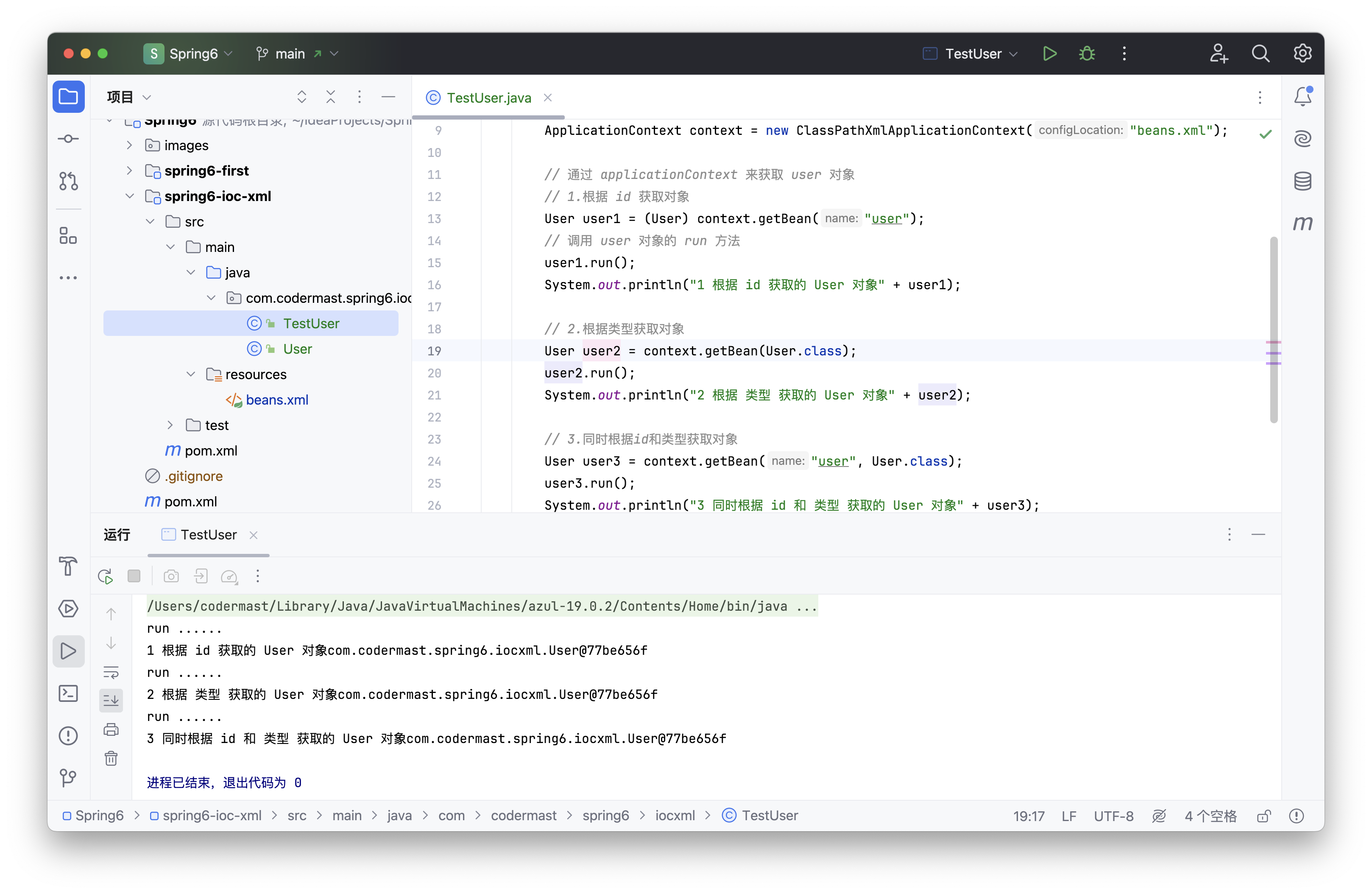
注意
- 要注意在 bean 的配置文件中,如果定义了两个相同的类,并赋予了不同的 id,那么此时就无法仅依靠类型来创建对象。
<!-- 创建user -->
<bean id="user" class="com.codermast.spring6.iocxml.User"/>
<bean id="user" class="com.codermast.spring6.iocxml.User"/>报错信息:
Exception in thread "main" org.springframework.beans.factory.NoUniqueBeanDefinition
Exception: No qualifying bean of type 'com.codermast.spring6.iocxml.User'
available: expected single matching bean but found 2: user,user1报错的意思就是,期望的应为单个匹配bean,但找到:user,user1 两个。
这个时候可以使用 id 或者 id和类型同时使用的方式进行获取,只要保证唯一性,理论上就可以创建。
是否可以根据接口类型来获取bean?
- 如果接口的实现唯一,此时可根据接口类型来获取该实现类的Bean
- 如果接口的实现不唯一,那么久无法根据接口类型来获取该实现类的Bean
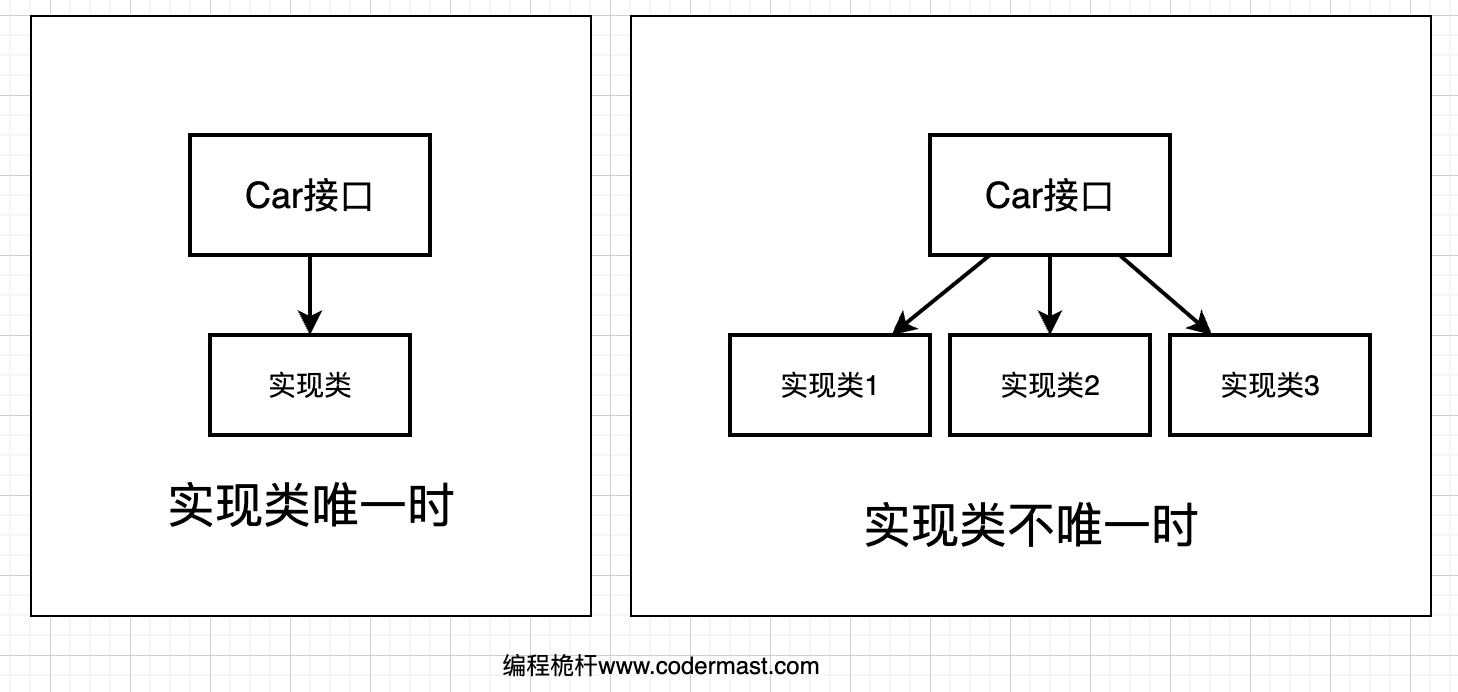
结论
根据类型来获取bean时,在满足 bean 唯一性的前提下,其实只是看:『对象 instanceof 指定的类型』的返回结果,只要返回的是 true 就可以认定为和类型匹配,能够获取到。
Java 中,instanceof运算符用于判断前面的对象是否是后面的类,或其子类、实现类的实例。如果是返回true,否则返回false。也就是说:用instanceof关键字做判断时, instanceof 操作符的左右操作必须有继承或实现关系
依赖注入
依赖注入DI(Dependency injection),是IOC的一个方面,是个通常的概念,它有多种解释。这概念是说你不用创建对象,而只需要描述它如何被创建。你不在代码里直接组装你的组件和服务,但是要在配置文件里描述哪些组件需要哪些服务,之后一个容器(IOC容器)负责把他们组装起来。
- 降低程序间的耦合(依赖关系)
- 依赖关系的管理:
- 以后都交给spring来维护
- 在当前类需要用到其他类的对象,由spring为我们提供,我们只需要在配置文件中说明依赖关系的维护,就称之为依赖注入。
提示
简单的来讲,依赖注入你只需要告诉他,所需要的各种数据在哪里去找即可,你不必亲自去找好交给他,让他自己去找所需要的依赖。
依赖注入主要有三种方式:Set方法注入、构造方法注入、注解注入
Set注入
在使用 Set 注入时,需要先创建对应属性的 Set 方法,否则无法进行注入。
- 创建 Student 类
点击展开代码
public class Student {
private Integer id;
private String name;
private Integer age;
private String sex;
public Student() {
}
public Integer getId() {
return id;
}
public void setId(Integer id) {
this.id = id;
}
public String getName() {
return name;
}
public void setName(String name) {
this.name = name;
}
public Integer getAge() {
return age;
}
public void setAge(Integer age) {
this.age = age;
}
public String getSex() {
return sex;
}
public void setSex(String sex) {
this.sex = sex;
}
@Override
public String toString() {
return "Student{" +
"id=" + id +
", name='" + name + '\'' +
", age=" + age +
", sex='" + sex + '\'' +
'}';
}
}- 配置 bean 时为属性赋值
创建一个新配置文件,名为 beans-di.xml ,添加如下配置
<bean id="studentOne" class="com.codermast.spring6.iocxml.bean.Student">
<!-- property标签:通过组件类的setXxx()方法给组件对象设置属性 -->
<!-- name属性:指定属性名(这个属性名是getXxx()、setXxx()方法定义的,和成员变量无关) -->
<!-- value属性:指定属性值 -->
<property name="id" value="1001"/>
<property name="name" value="张三"/>
<property name="age" value="23"/>
<property name="sex" value="男"/>
</bean>- 测试
@Test
public void setDiTest(){
// 1.导入 beans-di 配置文件
ApplicationContext ac = new ClassPathXmlApplicationContext("beans-di.xml");
// 2. 创建 Student 对象
Student studentOne = ac.getBean("studentOne", Student.class);
// 3. 打印 Student 对象
System.out.println(studentOne);
}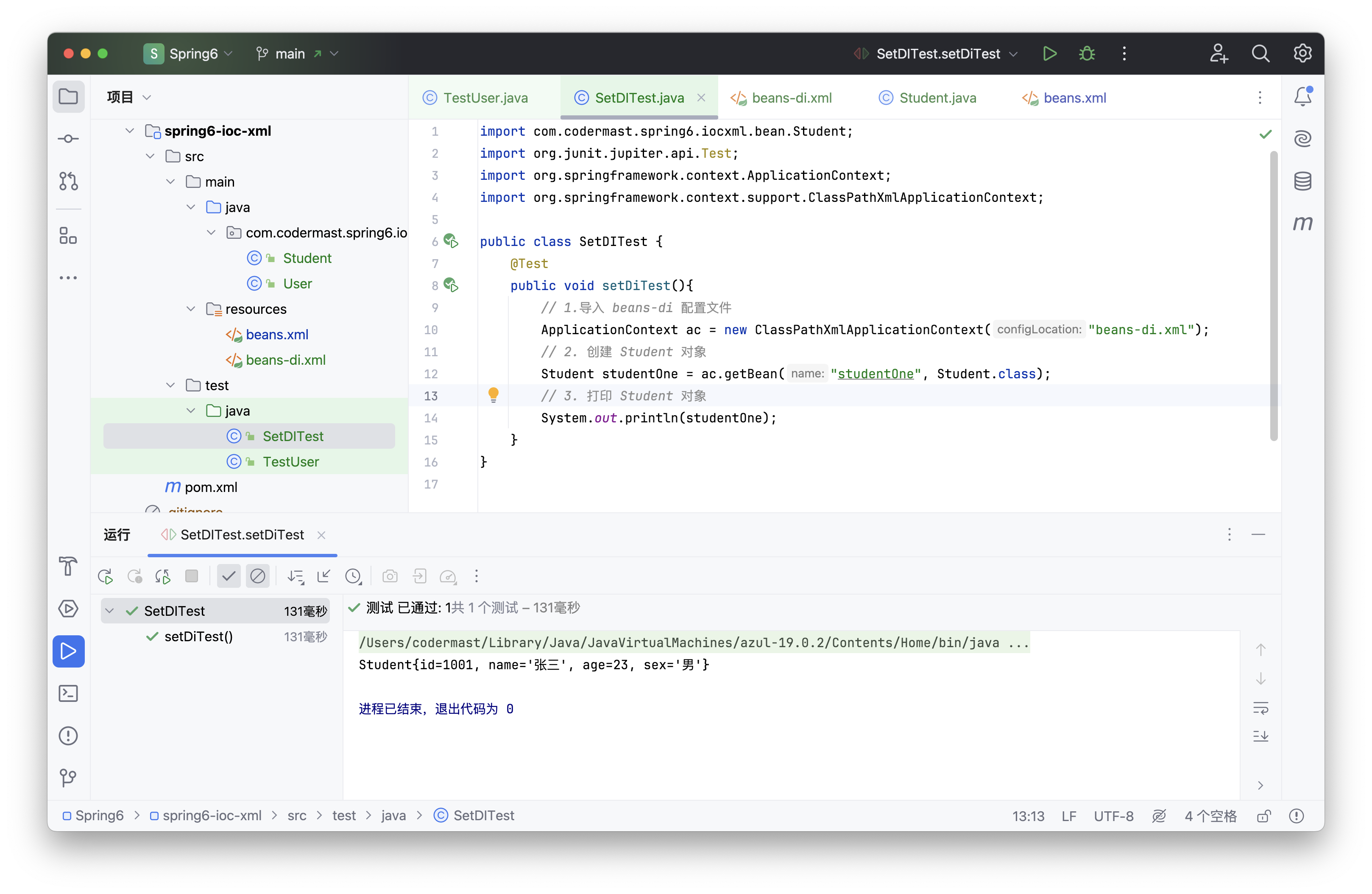
构造器注入
在使用构造器注入时和 Set 注入同理,需要先提供构造器,才可以使用构造器注入。
- 在 Student 类中添加有参构造器
public Student(Integer id, String name, Integer age, String sex) {
this.id = id;
this.name = name;
this.age = age;
this.sex = sex;
}- 配置对应的 bean
<!--创建构造器 bean-->
<bean id="studentTwo" class="com.codermast.spring6.iocxml.bean.Student">
<constructor-arg value="1002"/>
<constructor-arg value="李四"/>
<constructor-arg value="33"/>
<constructor-arg value="女"/>
</bean>注意
constructor-arg标签还有两个属性可以进一步描述构造器参数:
- index属性:指定参数所在位置的索引(从0开始)
- name属性:指定参数名
- 测试
@Test
public void constructDITest(){
// 1.导入 beans-di 配置文件
ApplicationContext ac = new ClassPathXmlApplicationContext("beans-di.xml");
// 2. 创建 Student 对象
Student studentTwo = ac.getBean("studentTwo", Student.class);
// 3. 打印 Student 对象
System.out.println(studentTwo);
}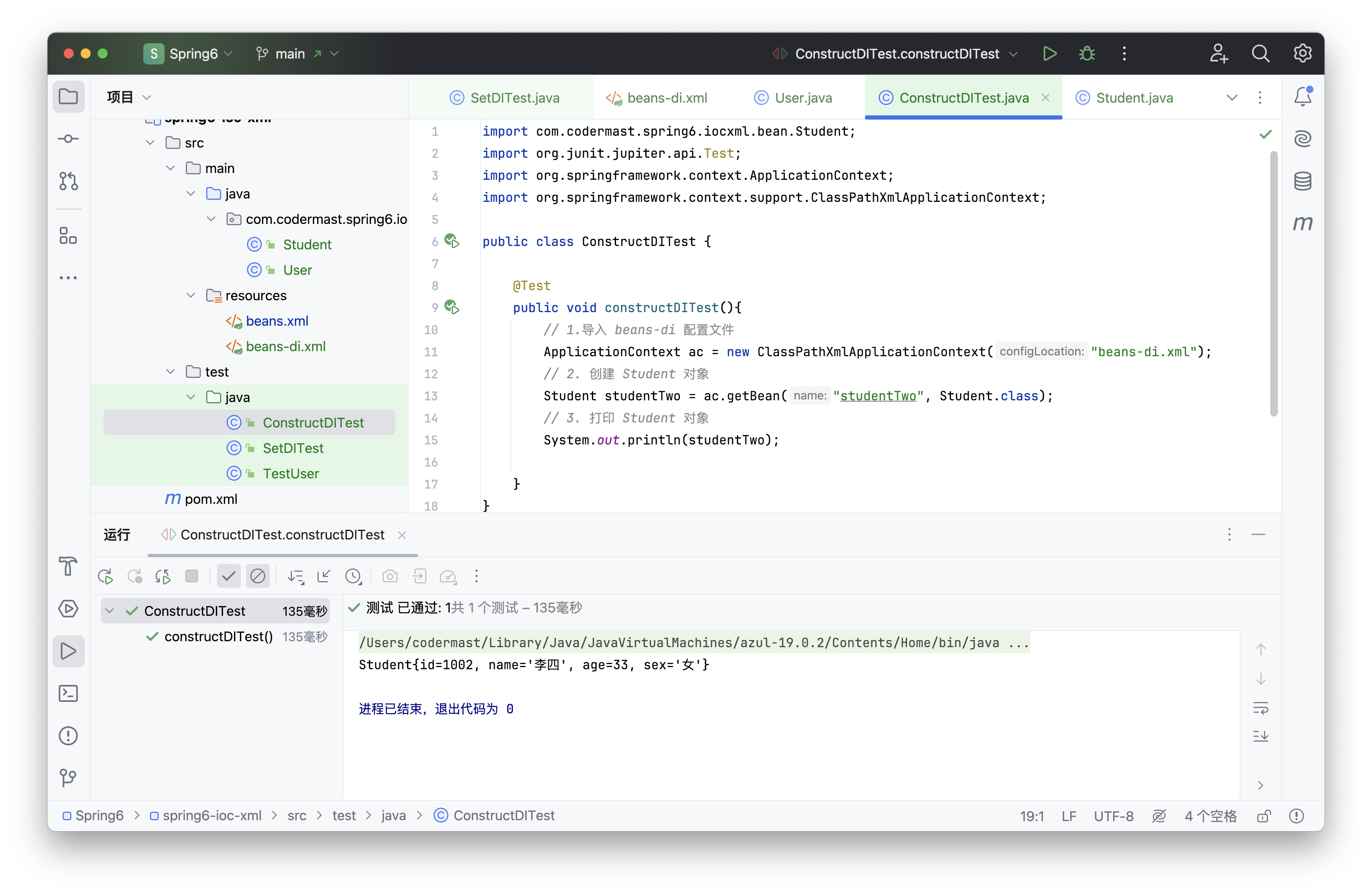
数据赋值
特殊值赋值
- 字面量值
字面量就是数据本身所代表的值,如 1、2、3、a、b、c等就代表的是实际的值,而在 int a = 10; 时,a 是变量,10为字面量。
<!-- 使用value属性给bean的属性赋值时,Spring会把value属性的值看做字面量 -->
<property name="name" value="张三"/>- null 值
<property name="name">
<null />
</property>需要注意的是,不能直接讲 null 作为 value 值进行传递,此时则为传递一个 内容为 null 的字符串,而并非传递 null 对象。
<property name="name" value="null"></property>- xml 实体
<!-- 小于号在XML文档中用来定义标签的开始,不能随便使用 -->
<!-- 解决方案一:使用XML实体来代替 -->
<property name="expression" value="a < b"/>- cdata 节
<property name="expression">
<!-- 解决方案二:使用CDATA节 -->
<!-- CDATA中的C代表Character,是文本、字符的含义,CDATA就表示纯文本数据 -->
<!-- XML解析器看到CDATA节就知道这里是纯文本,就不会当作XML标签或属性来解析 -->
<!-- 所以CDATA节中写什么符号都随意 -->
<value><![CDATA[a < b]]></value>
</property>对象类型属性赋值
- 创建 Clazz 类
在为对象类型属性赋值之前,我们先来创建一个名为 Clazz 的班级类(这里是为了避免和 Java 关键字 class 冲突)
点我展开代码
public class Clazz {
private Integer clazzId;
private String clazzName;
public Integer getClazzId() {
return clazzId;
}
public void setClazzId(Integer clazzId) {
this.clazzId = clazzId;
}
public String getClazzName() {
return clazzName;
}
public void setClazzName(String clazzName) {
this.clazzName = clazzName;
}
@Override
public String toString() {
return "Clazz{" +
"clazzId=" + clazzId +
", clazzName='" + clazzName + '\'' +
'}';
}
public Clazz() {
}
public Clazz(Integer clazzId, String clazzName) {
this.clazzId = clazzId;
this.clazzName = clazzName;
}
}- 修改 Student 类
private Clazz clazz;
public Clazz getClazz() {
return clazz;
}
public void setClazz(Clazz clazz) {
this.clazz = clazz;
}- 配置 Bean
这里我们在配置 Bean 的时候,有三种方式:外部bean、内部bean、级联属性赋值
外部bean
- 配置 Clazz 类
<bean id="clazzOne" class="com.codermast.spring6.iocxml.bean.Clazz"> <property name="clazzId" value="1111"/> <property name="clazzName" value="财源滚滚班"/> </bean>- 为 Student 中的 clazz 属性赋值
<bean id="studentFour" class="com.codermast.spring6.iocxml.bean.Student"> <property name="id" value="1004"/> <property name="name" value="赵六"/> <property name="age" value="26"/> <property name="sex" value="女"/> <!-- ref属性:引用IOC容器中某个bean的id,将所对应的bean为属性赋值 --> <property name="clazz" ref="clazzOne"/> </bean>内部bean
<bean id="studentFive" class="com.codermast.spring6.iocxml.bean.Student">
<property name="id" value="1004"/>
<property name="name" value="赵六"/>
<property name="age" value="26"/>
<property name="sex" value="女"/>
<property name="clazz">
<!-- 在一个bean中再声明一个bean就是内部bean -->
<!-- 内部bean只能用于给属性赋值,不能在外部通过IOC容器获取,因此可以省略id属性 -->
<bean id="clazzInner" class="com.codermast.spring6.iocxml.bean.Clazz">
<property name="clazzId" value="2222"/>
<property name="clazzName" value="远大前程班"/>
</bean>
</property>
</bean>- 级联属性赋值
<bean id="studentSix" class="com.codermast.spring6.iocxml.bean.Student">
<property name="id" value="1004"/>
<property name="name" value="赵六"/>
<property name="age" value="26"/>
<property name="sex" value="女"/>
<property name="clazz" ref="clazzOne"/>
<property name="clazz.clazzId" value="3333"/>
<property name="clazz.clazzName" value="最强王者班"/>
</bean>数组类型属性赋值
- 修改 Student 类
在 Student 类中增加如下代码:
private String[] hobbies;
public String[] getHobbies() {
return hobbies;
}
public void setHobbies(String[] hobbies) {
this.hobbies = hobbies;
}- 配置 bean
<bean id="studentSeven" class="com.codermast.spring6.iocxml.bean.Student">
<property name="id" value="1004"/>
<property name="name" value="赵六"/>
<property name="age" value="26"/>
<property name="sex" value="女"/>
<!-- ref属性:引用IOC容器中某个bean的id,将所对应的bean为属性赋值 -->
<property name="clazz" ref="clazzOne"/>
<property name="hobbies">
<array>
<value>抽烟</value>
<value>喝酒</value>
<value>烫头</value>
</array>
</property>
</bean>集合类型属性赋值
- List 集合
- 在 Clazz 类中加入如下代码
private List<Student> students;
public List<Student> getStudents() {
return students;
}
public void setStudents(List<Student> students) {
this.students = students;
}- 配置 bean
<bean id="clazzTwo" class="com.codermast.spring6.iocxml.bean.Clazz">
<property name="clazzId" value="4444"/>
<property name="clazzName" value="Javaee0222"/>
<property name="students">
<list>
<ref bean="studentOne"/>
<ref bean="studentTwo"/>
<ref bean="studentFour"/>
<ref bean="studentFive"/>
</list>
</property>
</bean>若为 Set 集合类型属性赋值,只需要将其中的 list 标签改为set标签即可。
- Map 集合
- 创建 Teacher 类
点我展开代码
public class Teacher {
private Integer teacherId;
private String teacherName;
public Integer getTeacherId() {
return teacherId;
}
public void setTeacherId(Integer teacherId) {
this.teacherId = teacherId;
}
public String getTeacherName() {
return teacherName;
}
public void setTeacherName(String teacherName) {
this.teacherName = teacherName;
}
public Teacher(Integer teacherId, String teacherName) {
this.teacherId = teacherId;
this.teacherName = teacherName;
}
public Teacher() {
}
@Override
public String toString() {
return "Teacher{" +
"teacherId=" + teacherId +
", teacherName='" + teacherName + '\'' +
'}';
}
}- 在 Student 类中加入如下代码
private Map<String, Teacher> teacherMap;
public Map<String, Teacher> getTeacherMap() {
return teacherMap;
}
public void setTeacherMap(Map<String, Teacher> teacherMap) {
this.teacherMap = teacherMap;
}- 配置bean
<!-- Map 集合配置-->
<bean id="teacherOne" class="com.codermast.spring6.iocxml.bean.Teacher">
<property name="teacherId" value="10010"/>
<property name="teacherName" value="大宝"/>
</bean>
<bean id="teacherTwo" class="com.codermast.spring6.iocxml.bean.Teacher">
<property name="teacherId" value="10086"/>
<property name="teacherName" value="二宝"/>
</bean>
<bean id="studentFour" class="com.codermast.spring6.iocxml.bean.Student">
<property name="id" value="1004"/>
<property name="name" value="赵六"/>
<property name="age" value="26"/>
<property name="sex" value="女"/>
<!-- ref属性:引用IOC容器中某个bean的id,将所对应的bean为属性赋值 -->
<property name="clazz" ref="clazzOne"/>
<property name="hobbies">
<array>
<value>抽烟</value>
<value>喝酒</value>
<value>烫头</value>
</array>
</property>
<property name="teacherMap">
<map>
<entry value-ref="teacherOne">
<key>
<value>10010</value>
</key>
</entry>
<entry value-ref="teacherTwo">
<key>
<value>10086</value>
</key>
</entry>
</map>
</property>
</bean>- 引用集合类型
<!--list集合类型的bean-->
<util:list id="students">
<ref bean="studentOne"/>
<ref bean="studentTwo"/>
<ref bean="studentFour"/>
</util:list>
<!--map集合类型的bean-->
<util:map id="teacherMap">
<entry>
<key>
<value>10010</value>
</key>
<ref bean="teacherOne"/>
</entry>
<entry>
<key>
<value>10086</value>
</key>
<ref bean="teacherTwo"/>
</entry>
</util:map>
<bean id="clazzTwo" class="com.codermast.spring6.iocxml.bean.Clazz">
<property name="clazzId" value="4444"/>
<property name="clazzName" value="Javaee0222"/>
<property name="students" ref="students"/>
</bean>
<bean id="studentFour" class="com.codermast.spring6.iocxml.bean.Student">
<property name="id" value="1004"/>
<property name="name" value="赵六"/>
<property name="age" value="26"/>
<property name="sex" value="女"/>
<!-- ref属性:引用IOC容器中某个bean的id,将所对应的bean为属性赋值 -->
<property name="clazz" ref="clazzOne"/>
<property name="hobbies">
<array>
<value>抽烟</value>
<value>喝酒</value>
<value>烫头</value>
</array>
</property>
<property name="teacherMap" ref="teacherMap"/>
</bean>使用util:list、util:map标签必须引入相应的命名空间
<?xml version="1.0" encoding="UTF-8"?>
<beans xmlns="http://www.springframework.org/schema/beans"
xmlns:xsi="http://www.w3.org/2001/XMLSchema-instance"
xmlns:util="http://www.springframework.org/schema/util"
xsi:schemaLocation="http://www.springframework.org/schema/util
http://www.springframework.org/schema/util/spring-util.xsd
http://www.springframework.org/schema/beans
http://www.springframework.org/schema/beans/spring-beans.xsd">P命名空间
- 引入 P 命名空间
<?xml version="1.0" encoding="UTF-8"?>
<beans xmlns="http://www.springframework.org/schema/beans"
xmlns:xsi="http://www.w3.org/2001/XMLSchema-instance"
xmlns:util="http://www.springframework.org/schema/util"
xmlns:p="http://www.springframework.org/schema/p"
xsi:schemaLocation="http://www.springframework.org/schema/util
http://www.springframework.org/schema/util/spring-util.xsd
http://www.springframework.org/schema/beans
http://www.springframework.org/schema/beans/spring-beans.xsd">- 引入p命名空间后,可以通过以下方式为bean的各个属性赋值
<bean id="studentSix" class="com.codermast.spring6.iocxml.bean.Student"
p:id="1006" p:name="小明" p:clazz-ref="clazzOne" p:teacherMap-ref="teacherMap"></bean>引入外部属性文件
- 加入依赖
即将下面的代码,加入到对应子模块中的 pom.xml 文件中
<!-- MySQL驱动 -->
<dependency>
<groupId>mysql</groupId>
<artifactId>mysql-connector-java</artifactId>
<version>8.0.30</version>
</dependency>
<!-- 数据源 -->
<dependency>
<groupId>com.alibaba</groupId>
<artifactId>druid</artifactId>
<version>1.2.15</version>
</dependency>- 创建外部属性配置文件jdbc.properties
jdbc.user=codermast
jdbc.password=123456
jdbc.url=jdbc:mysql://localhost:3306/ssm?serverTimezone=UTC
jdbc.driver=com.mysql.cj.jdbc.Driver- 引入配置文件
引入context 名称空间,这里我们为了防止和之前的冲突,新建一个 bean 配置文件,名为 spring-datasource.xml
<?xml version="1.0" encoding="UTF-8"?>
<beans xmlns="http://www.springframework.org/schema/beans"
xmlns:xsi="http://www.w3.org/2001/XMLSchema-instance"
xmlns:context="http://www.springframework.org/schema/context"
xsi:schemaLocation="http://www.springframework.org/schema/beans
http://www.springframework.org/schema/beans/spring-beans.xsd
http://www.springframework.org/schema/context
http://www.springframework.org/schema/context/spring-context.xsd">
<!-- 引入外部属性文件 -->
<context:property-placeholder location="classpath:jdbc.properties"/>
</beans>注意:
在使用 <context:property-placeholder> 元素加载外包配置文件功能前,首先需要在 XML 配置的一级标签 <beans> 中添加 context 相关的约束。
- 配置bean
<bean id="druidDataSource" class="com.alibaba.druid.pool.DruidDataSource">
<property name="url" value="${jdbc.url}"/>
<property name="driverClassName" value="${jdbc.driver}"/>
<property name="username" value="${jdbc.user}"/>
<property name="password" value="${jdbc.password}"/>
</bean>- 测试
@Test
public void testDataSource() throws SQLException {
ApplicationContext ac = new ClassPathXmlApplicationContext("spring-datasource.xml");
DataSource dataSource = ac.getBean(DataSource.class);
Connection connection = dataSource.getConnection();
System.out.println(connection);
}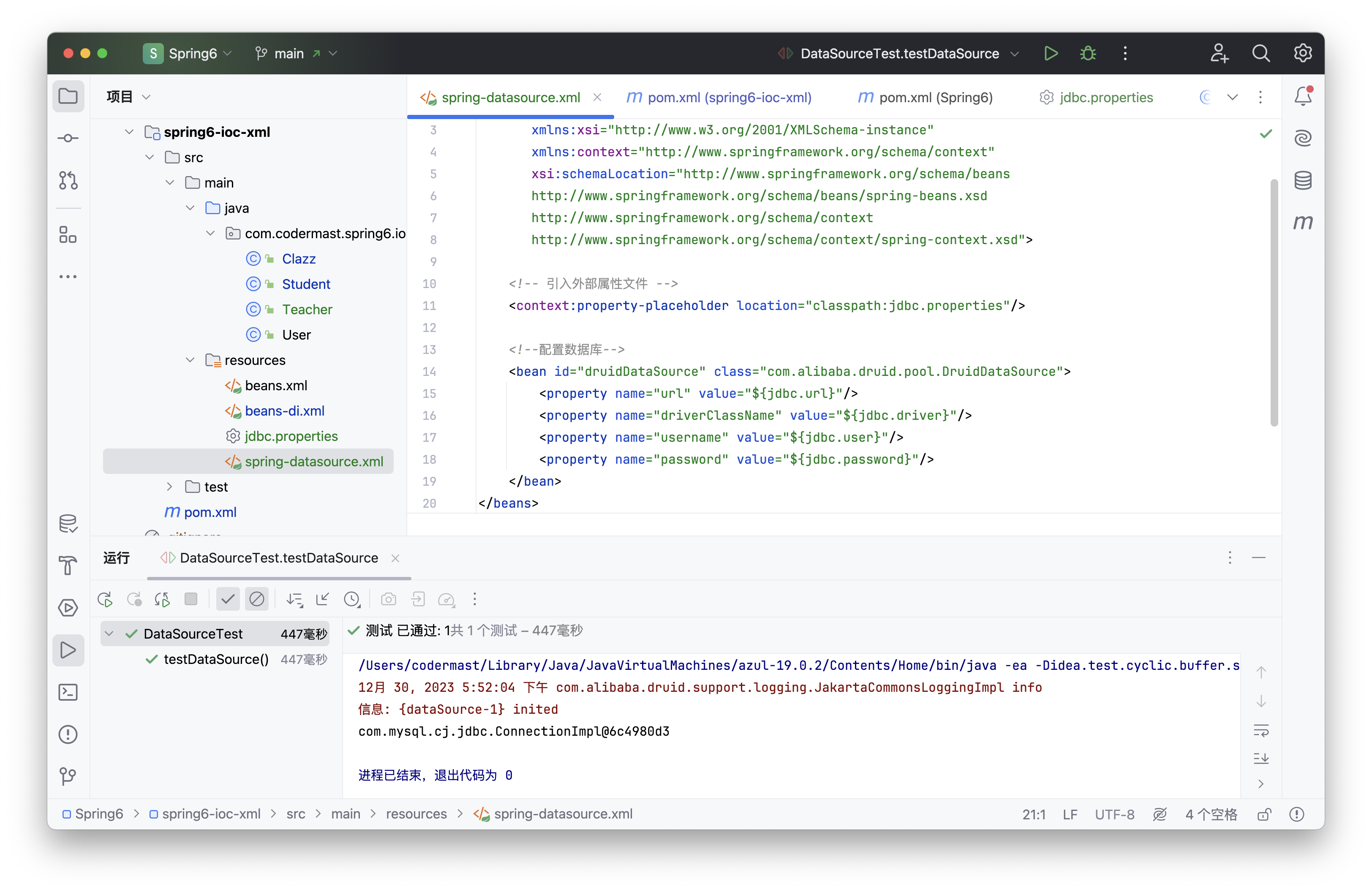
Bean的作用域
- 概念
在Spring中可以通过配置bean标签的scope属性来指定bean的作用域范围,各取值含义参加下表:
| 取值 | 含义 | 创建对象的时机 |
|---|---|---|
| singleton(默认) | 在IOC容器中,这个bean的对象始终为单实例 | IOC容器初始化时 |
| prototype | 这个bean在IOC容器中有多个实例 | 获取bean时 |
如果是在WebApplicationContext环境下还会有另外几个作用域(但不常用):
| 取值 | 含义 |
|---|---|
| request | 在一个请求范围内有效 |
| session | 在一个会话范围内有效 |
- 创建 User 类
点我展开代码
package com.atguigu.spring6.bean;
public class User {
private Integer id;
private String username;
private String password;
private Integer age;
public User() {
}
public User(Integer id, String username, String password, Integer age) {
this.id = id;
this.username = username;
this.password = password;
this.age = age;
}
public Integer getId() {
return id;
}
public void setId(Integer id) {
this.id = id;
}
public String getUsername() {
return username;
}
public void setUsername(String username) {
this.username = username;
}
public String getPassword() {
return password;
}
public void setPassword(String password) {
this.password = password;
}
public Integer getAge() {
return age;
}
public void setAge(Integer age) {
this.age = age;
}
@Override
public String toString() {
return "User{" +
"id=" + id +
", username='" + username + '\'' +
", password='" + password + '\'' +
", age=" + age +
'}';
}
}这里也可以使用我们之前的 User 类,不影响后续的操作。
- 配置bean
<!-- 配置 User 类 -->
<bean id="userSingleton" class="com.codermast.spring6.iocxml.bean.User" scope="singleton"/>
<bean id="userPrototype" class="com.codermast.spring6.iocxml.bean.User" scope="prototype"/>- 测试
@Test
public void testBeanScope(){
ApplicationContext ac = new ClassPathXmlApplicationContext("spring-scope.xml");
User user1 = ac.getBean(User.class);
User user2 = ac.getBean(User.class);
System.out.println(user1==user2);
}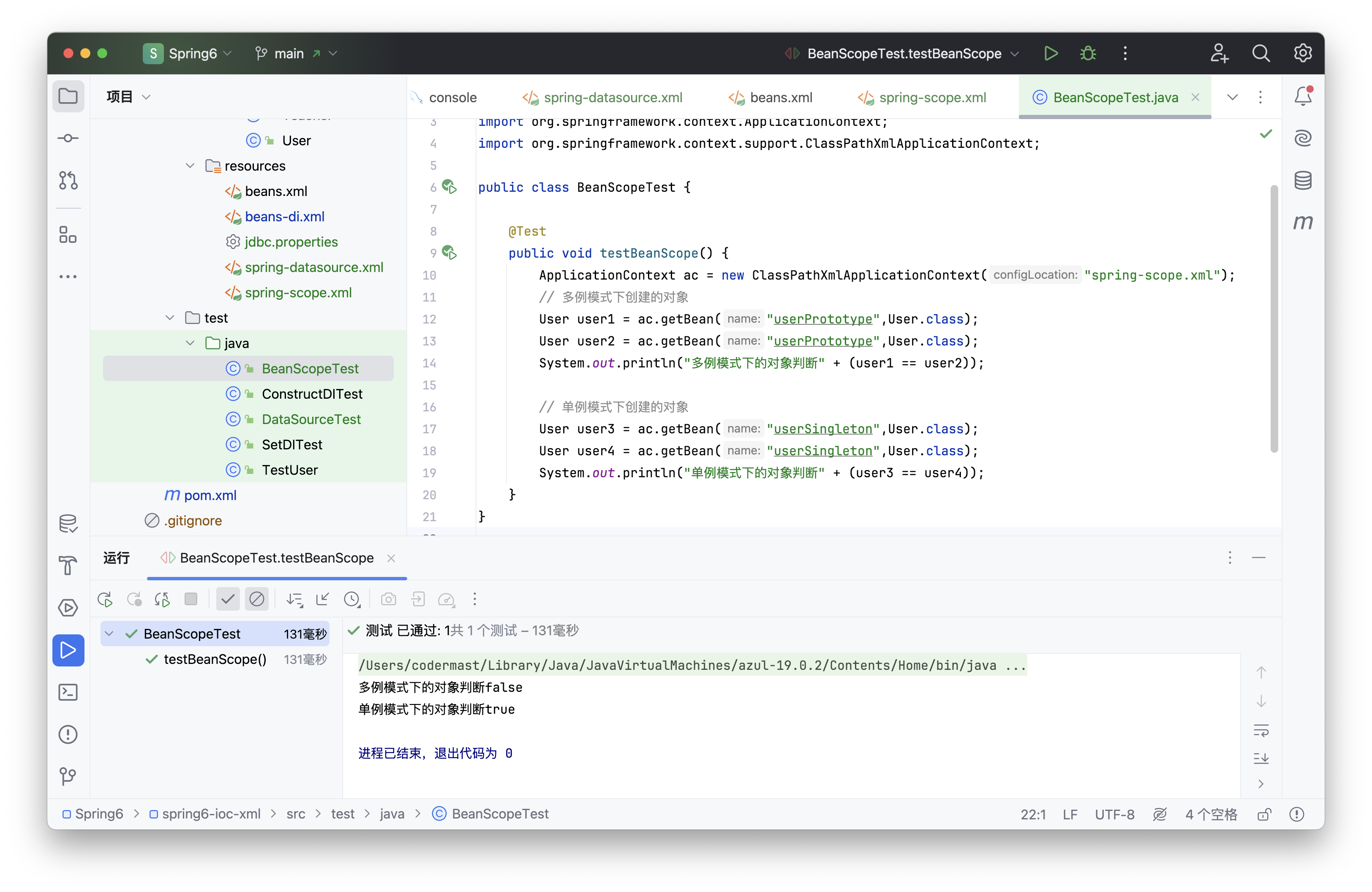
Bean生命周期
- 具体的生命周期过程
bean对象创建(调用无参构造器)
给bean对象设置属性
bean的后置处理器(初始化之前)
bean对象初始化(需在配置bean时指定初始化方法)
bean的后置处理器(初始化之后)
bean对象就绪可以使用
bean对象销毁(需在配置bean时指定销毁方法)
IOC容器关闭
- 修改 User 类
点我展开代码
public class User {
private Integer id;
private String username;
private String password;
private Integer age;
public User() {
System.out.println("生命周期:1、创建对象");
}
public User(Integer id, String username, String password, Integer age) {
this.id = id;
this.username = username;
this.password = password;
this.age = age;
}
public Integer getId() {
return id;
}
public void setId(Integer id) {
System.out.println("生命周期:2、依赖注入");
this.id = id;
}
public String getUsername() {
return username;
}
public void setUsername(String username) {
this.username = username;
}
public String getPassword() {
return password;
}
public void setPassword(String password) {
this.password = password;
}
public Integer getAge() {
return age;
}
public void setAge(Integer age) {
this.age = age;
}
public void initMethod(){
System.out.println("生命周期:3、初始化");
}
public void destroyMethod(){
System.out.println("生命周期:5、销毁");
}
@Override
public String toString() {
return "User{" +
"id=" + id +
", username='" + username + '\'' +
", password='" + password + '\'' +
", age=" + age +
'}';
}
public void run(){
System.out.println("run ......");
}
}注意其中的initMethod()和destroyMethod(),可以通过配置bean指定为初始化和销毁的方法
- 配置bean
<!-- 使用init-method属性指定初始化方法 -->
<!-- 使用destroy-method属性指定销毁方法 -->
<bean class="com.codermast.spring6.iocxml.bean.User" scope="prototype" init-method="initMethod" destroy-method="destroyMethod">
<property name="id" value="1001"/>
<property name="username" value="admin"/>
<property name="password" value="123456"/>
<property name="age" value="23"/>
</bean>- 测试
@Test
public void testLife(){
ClassPathXmlApplicationContext ac = new ClassPathXmlApplicationContext("spring-lifecycle.xml");
User bean = ac.getBean(User.class);
System.out.println("生命周期:4、通过IOC容器获取bean并使用");
ac.close();
}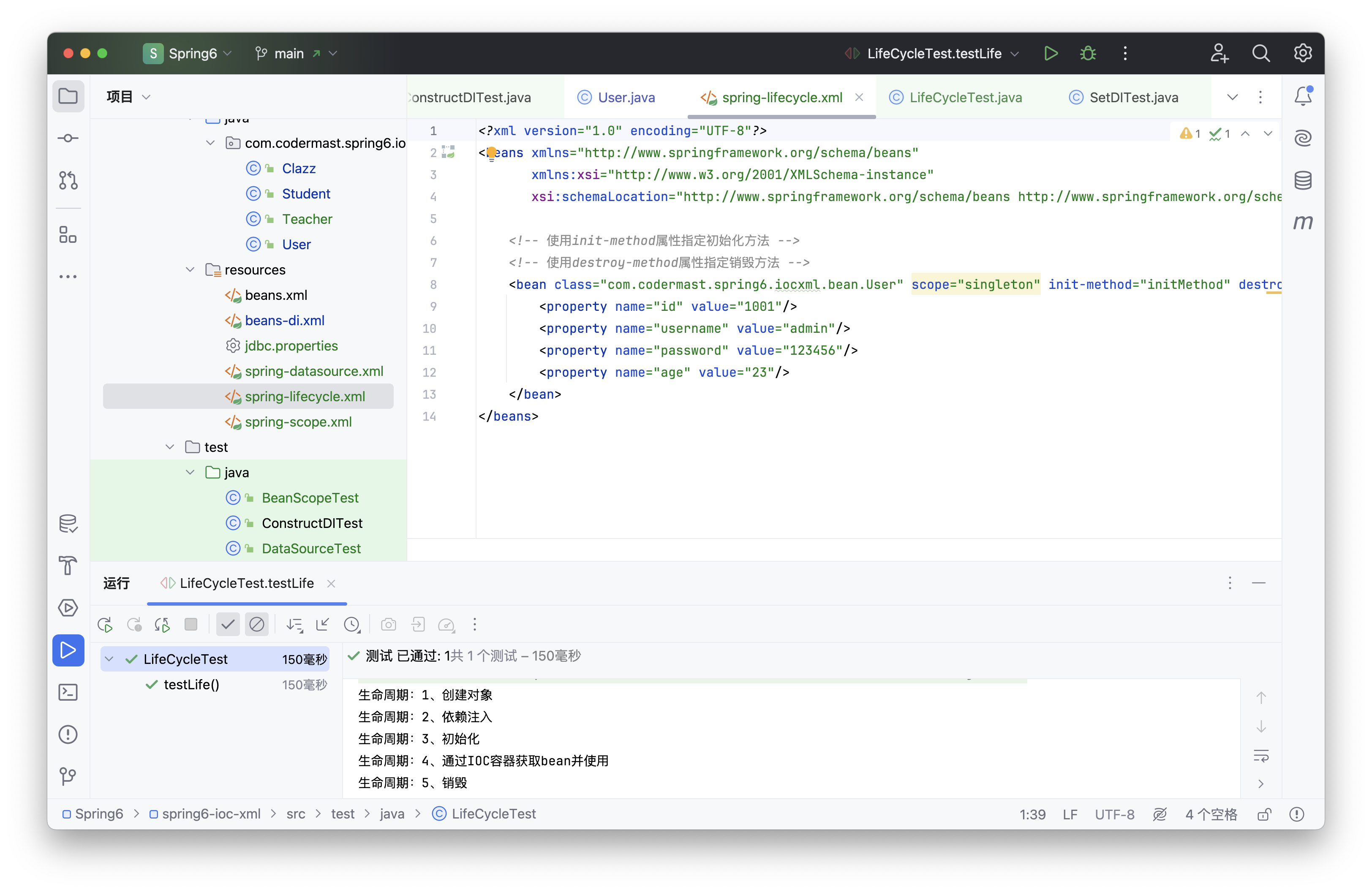
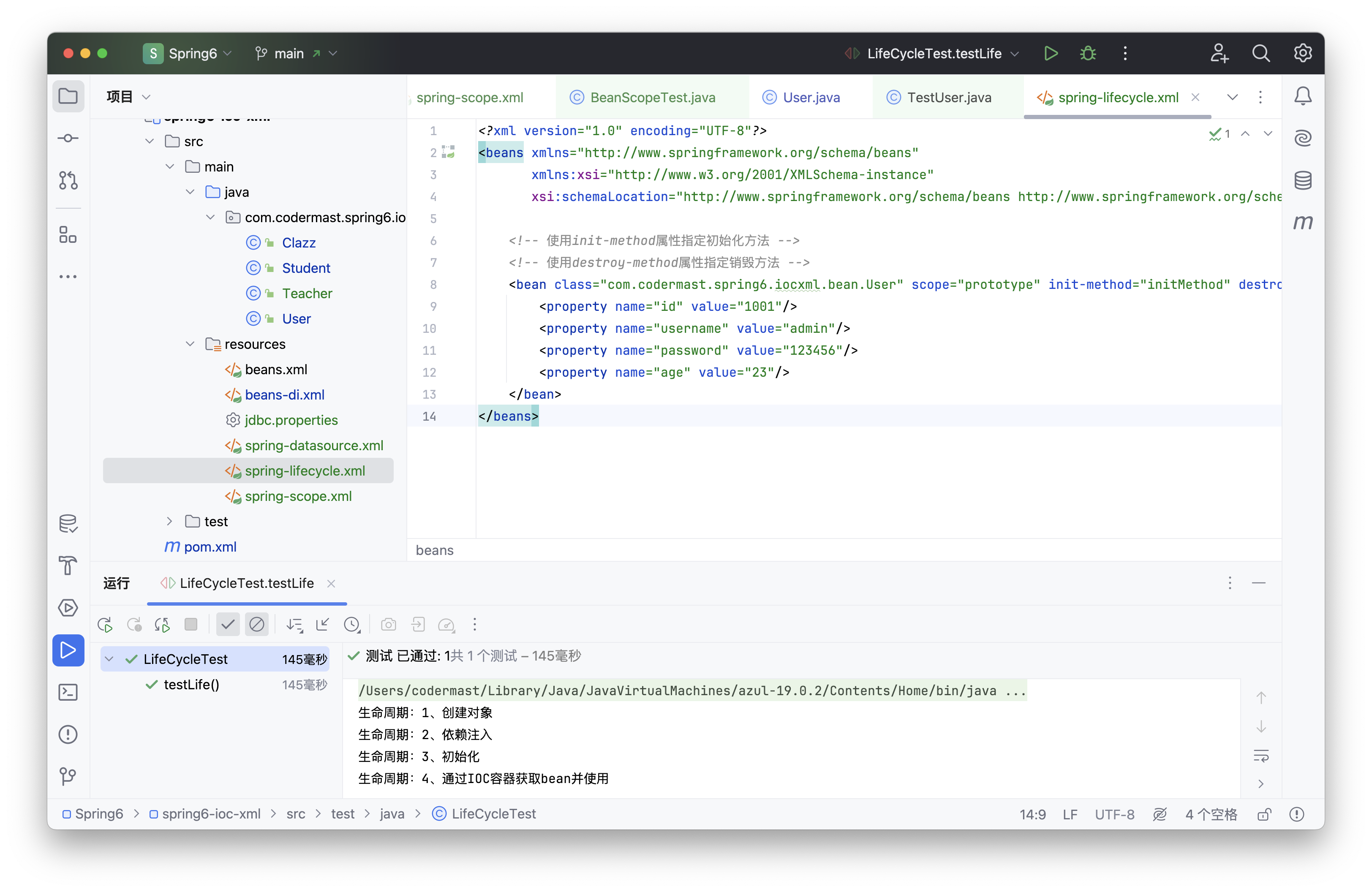
只有在单例模式下,执行 close 方法才会调用 destroyMethod 销毁方法。
- bean的后置处理器
bean的后置处理器会在生命周期的初始化前后添加额外的操作,需要实现BeanPostProcessor接口,且配置到IOC容器中,需要注意的是,bean后置处理器不是单独针对某一个bean生效,而是针对IOC容器中所有bean都会执行
创建bean的后置处理器:
public class MyBeanProcessor implements BeanPostProcessor {
// 初始化之前调用
@Override
public Object postProcessBeforeInitialization(Object bean, String beanName) throws BeansException {
System.out.println("☆☆☆" + beanName + " = " + bean);
return bean;
}
// 初始化之后调用
@Override
public Object postProcessAfterInitialization(Object bean, String beanName) throws BeansException {
System.out.println("★★★" + beanName + " = " + bean);
return bean;
}
}在IOC容器中配置后置处理器:
<!-- bean的后置处理器要放入IOC容器才能生效 -->
<bean id="myBeanProcessor" class="com.atguigu.spring6.process.MyBeanProcessor"/>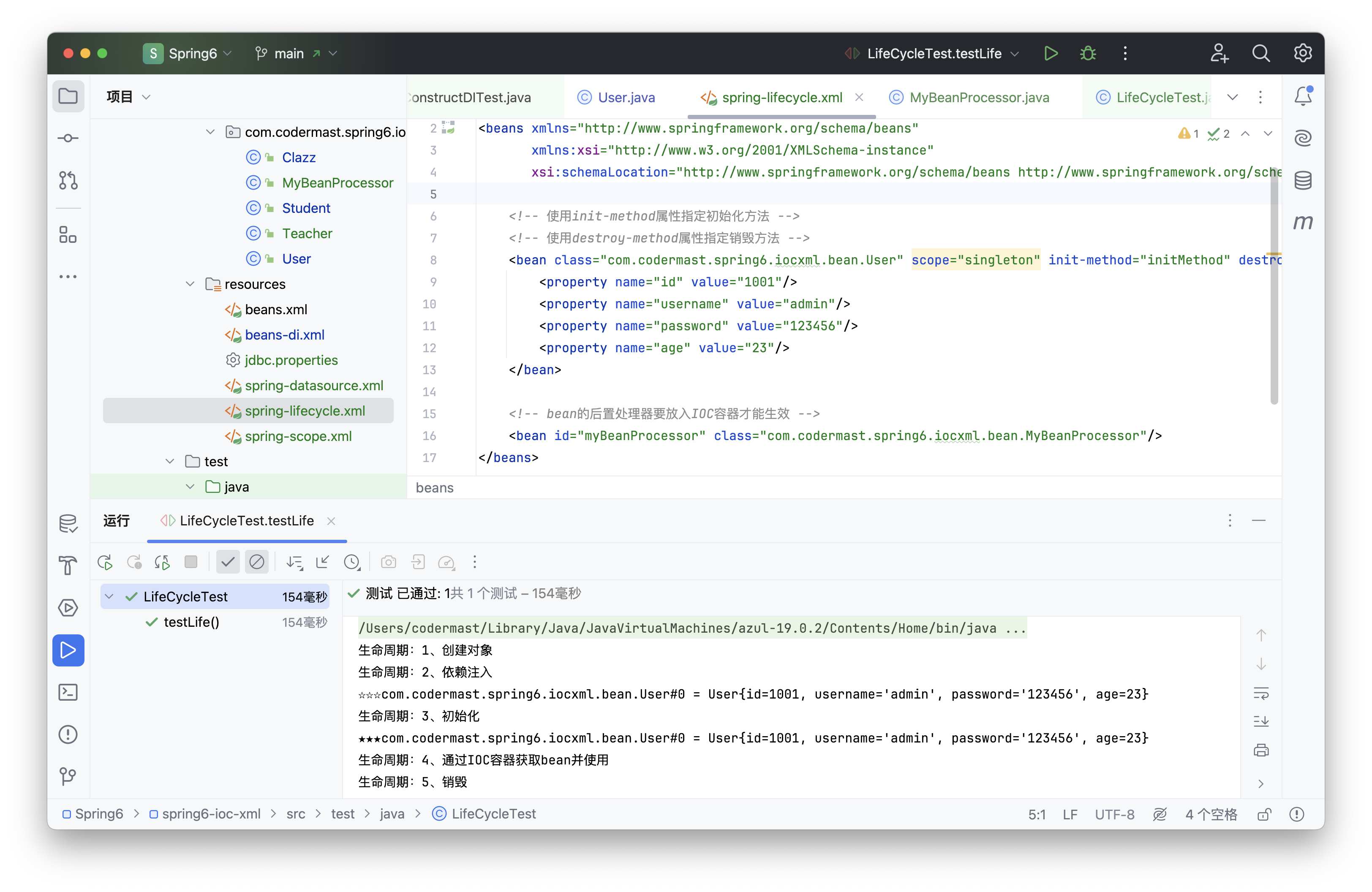
FactoryBean
- 简介
FactoryBean是Spring提供的一种整合第三方框架的常用机制。和普通的bean不同,配置一个FactoryBean类型的bean,在获取bean的时候得到的并不是class属性中配置的这个类的对象,而是getObject()方法的返回值。通过这种机制,Spring可以帮我们把复杂组件创建的详细过程和繁琐细节都屏蔽起来,只把最简洁的使用界面展示给我们。
将来我们整合Mybatis时,Spring就是通过FactoryBean机制来帮我们创建SqlSessionFactory对象的。
FactoryBean接口源码
/*
* Copyright 2002-2020 the original author or authors.
*
* Licensed under the Apache License, Version 2.0 (the "License");
* you may not use this file except in compliance with the License.
* You may obtain a copy of the License at
*
* https://www.apache.org/licenses/LICENSE-2.0
*
* Unless required by applicable law or agreed to in writing, software
* distributed under the License is distributed on an "AS IS" BASIS,
* WITHOUT WARRANTIES OR CONDITIONS OF ANY KIND, either express or implied.
* See the License for the specific language governing permissions and
* limitations under the License.
*/
package org.springframework.beans.factory;
import org.springframework.lang.Nullable;
/**
* Interface to be implemented by objects used within a {@link BeanFactory} which
* are themselves factories for individual objects. If a bean implements this
* interface, it is used as a factory for an object to expose, not directly as a
* bean instance that will be exposed itself.
*
* <p><b>NB: A bean that implements this interface cannot be used as a normal bean.</b>
* A FactoryBean is defined in a bean style, but the object exposed for bean
* references ({@link #getObject()}) is always the object that it creates.
*
* <p>FactoryBeans can support singletons and prototypes, and can either create
* objects lazily on demand or eagerly on startup. The {@link SmartFactoryBean}
* interface allows for exposing more fine-grained behavioral metadata.
*
* <p>This interface is heavily used within the framework itself, for example for
* the AOP {@link org.springframework.aop.framework.ProxyFactoryBean} or the
* {@link org.springframework.jndi.JndiObjectFactoryBean}. It can be used for
* custom components as well; however, this is only common for infrastructure code.
*
* <p><b>{@code FactoryBean} is a programmatic contract. Implementations are not
* supposed to rely on annotation-driven injection or other reflective facilities.</b>
* {@link #getObjectType()} {@link #getObject()} invocations may arrive early in the
* bootstrap process, even ahead of any post-processor setup. If you need access to
* other beans, implement {@link BeanFactoryAware} and obtain them programmatically.
*
* <p><b>The container is only responsible for managing the lifecycle of the FactoryBean
* instance, not the lifecycle of the objects created by the FactoryBean.</b> Therefore,
* a destroy method on an exposed bean object (such as {@link java.io.Closeable#close()}
* will <i>not</i> be called automatically. Instead, a FactoryBean should implement
* {@link DisposableBean} and delegate any such close call to the underlying object.
*
* <p>Finally, FactoryBean objects participate in the containing BeanFactory's
* synchronization of bean creation. There is usually no need for internal
* synchronization other than for purposes of lazy initialization within the
* FactoryBean itself (or the like).
*
* @author Rod Johnson
* @author Juergen Hoeller
* @since 08.03.2003
* @param <T> the bean type
* @see org.springframework.beans.factory.BeanFactory
* @see org.springframework.aop.framework.ProxyFactoryBean
* @see org.springframework.jndi.JndiObjectFactoryBean
*/
public interface FactoryBean<T> {
/**
* The name of an attribute that can be
* {@link org.springframework.core.AttributeAccessor#setAttribute set} on a
* {@link org.springframework.beans.factory.config.BeanDefinition} so that
* factory beans can signal their object type when it can't be deduced from
* the factory bean class.
* @since 5.2
*/
String OBJECT_TYPE_ATTRIBUTE = "factoryBeanObjectType";
/**
* Return an instance (possibly shared or independent) of the object
* managed by this factory.
* <p>As with a {@link BeanFactory}, this allows support for both the
* Singleton and Prototype design pattern.
* <p>If this FactoryBean is not fully initialized yet at the time of
* the call (for example because it is involved in a circular reference),
* throw a corresponding {@link FactoryBeanNotInitializedException}.
* <p>As of Spring 2.0, FactoryBeans are allowed to return {@code null}
* objects. The factory will consider this as normal value to be used; it
* will not throw a FactoryBeanNotInitializedException in this case anymore.
* FactoryBean implementations are encouraged to throw
* FactoryBeanNotInitializedException themselves now, as appropriate.
* @return an instance of the bean (can be {@code null})
* @throws Exception in case of creation errors
* @see FactoryBeanNotInitializedException
*/
@Nullable
T getObject() throws Exception;
/**
* Return the type of object that this FactoryBean creates,
* or {@code null} if not known in advance.
* <p>This allows one to check for specific types of beans without
* instantiating objects, for example on autowiring.
* <p>In the case of implementations that are creating a singleton object,
* this method should try to avoid singleton creation as far as possible;
* it should rather estimate the type in advance.
* For prototypes, returning a meaningful type here is advisable too.
* <p>This method can be called <i>before</i> this FactoryBean has
* been fully initialized. It must not rely on state created during
* initialization; of course, it can still use such state if available.
* <p><b>NOTE:</b> Autowiring will simply ignore FactoryBeans that return
* {@code null} here. Therefore it is highly recommended to implement
* this method properly, using the current state of the FactoryBean.
* @return the type of object that this FactoryBean creates,
* or {@code null} if not known at the time of the call
* @see ListableBeanFactory#getBeansOfType
*/
@Nullable
Class<?> getObjectType();
/**
* Is the object managed by this factory a singleton? That is,
* will {@link #getObject()} always return the same object
* (a reference that can be cached)?
* <p><b>NOTE:</b> If a FactoryBean indicates to hold a singleton object,
* the object returned from {@code getObject()} might get cached
* by the owning BeanFactory. Hence, do not return {@code true}
* unless the FactoryBean always exposes the same reference.
* <p>The singleton status of the FactoryBean itself will generally
* be provided by the owning BeanFactory; usually, it has to be
* defined as singleton there.
* <p><b>NOTE:</b> This method returning {@code false} does not
* necessarily indicate that returned objects are independent instances.
* An implementation of the extended {@link SmartFactoryBean} interface
* may explicitly indicate independent instances through its
* {@link SmartFactoryBean#isPrototype()} method. Plain {@link FactoryBean}
* implementations which do not implement this extended interface are
* simply assumed to always return independent instances if the
* {@code isSingleton()} implementation returns {@code false}.
* <p>The default implementation returns {@code true}, since a
* {@code FactoryBean} typically manages a singleton instance.
* @return whether the exposed object is a singleton
* @see #getObject()
* @see SmartFactoryBean#isPrototype()
*/
default boolean isSingleton() {
return true;
}
}- 创建类UserFactoryBean
public class UserFactoryBean implements FactoryBean<User> {
@Override
public User getObject() throws Exception {
return new User();
}
@Override
public Class<?> getObjectType() {
return User.class;
}
}- 配置bean
<bean id="user" class="com.codermast.spring6.iocxml.bean.UserFactoryBean"/>- 测试
@Test
public void testUserFactoryBean(){
//获取IOC容器
ApplicationContext ac = new ClassPathXmlApplicationContext("bean-factorybean.xml");
User user = (User) ac.getBean("user");
System.out.println(user);
System.out.println(user.getClass());
}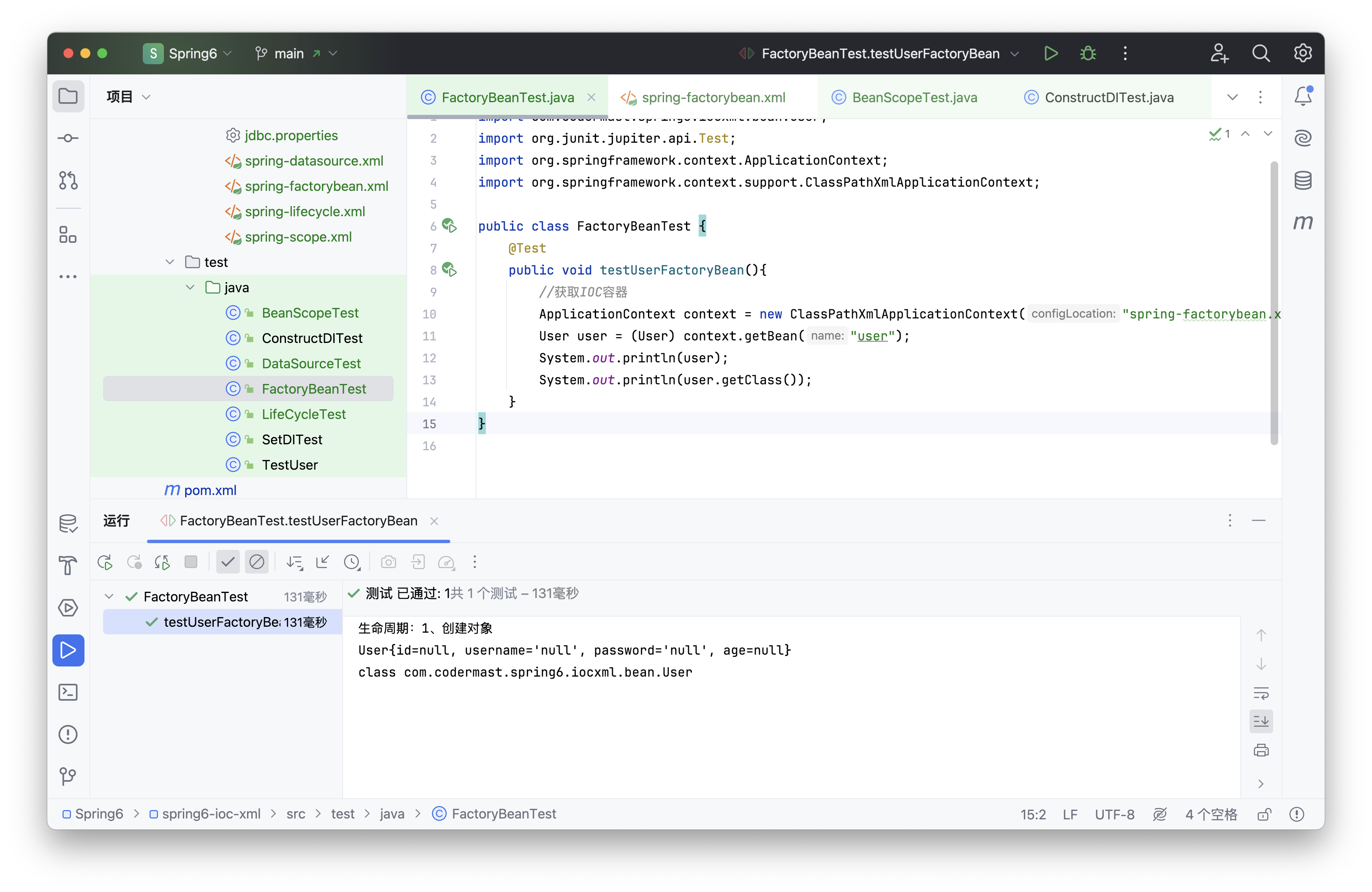
基于xml自动装配
自动装配:根据指定的策略,在IOC容器中匹配某一个bean,自动为指定的bean中所依赖的类类型或接口类型属性赋值
- 场景模拟
创建类UserController
public class UserController {
private UserService userService;
public void setUserService(UserService userService) {
this.userService = userService;
}
public void saveUser(){
userService.saveUser();
}
}创建接口UserService
public interface UserService {
void saveUser();
}创建类UserServiceImpl实现接口UserService
public class UserServiceImpl implements UserService {
private UserDao userDao;
public void setUserDao(UserDao userDao) {
this.userDao = userDao;
}
@Override
public void saveUser() {
userDao.saveUser();
}
}创建接口UserDao
public interface UserDao {
void saveUser();
}创建类UserDaoImpl实现接口UserDao
public class UserDaoImpl implements UserDao{
@Override
public void saveUser() {
System.out.println("保存成功");
}
}2.配置bean
使用bean标签的autowire属性设置自动装配效果
- 自动装配方式:byType
byType:根据类型匹配IOC容器中的某个兼容类型的bean,为属性自动赋值
若在IOC中,没有任何一个兼容类型的bean能够为属性赋值,则该属性不装配,即值为默认值null
若在IOC中,有多个兼容类型的bean能够为属性赋值,则抛出异常NoUniqueBeanDefinitionException
autowire-byType.xml
<!--自动装配 :byType 方式-->
<bean id="userController" class="com.codermast.spring6.iocxml.bean.autowire.controller.UserController"
autowire="byType"/>
<bean id="userService" class="com.codermast.spring6.iocxml.bean.autowire.service.UserServiceImpl"
autowire="byType"/>
<bean id="userDao" class="com.codermast.spring6.iocxml.bean.autowire.dao.UserDaoImpl"/>- 自动装配方式:byName
byName:将自动装配的属性的属性名,作为bean的id在IOC容器中匹配相对应的bean进行赋值
autowire-byName.xml
<!--自动装配:byName 方式-->
<bean id="userController" class="com.codermast.spring6.iocxml.bean.autowire.controller.UserController"
autowire="byName"/>
<bean id="userService" class="com.codermast.spring6.iocxml.bean.autowire.service.UserServiceImpl"
autowire="byName"/>
<bean id="userServiceImpl" class="com.codermast.spring6.iocxml.bean.autowire.service.UserServiceImpl"
autowire="byName"/>
<bean id="userDao" class="com.codermast.spring6.iocxml.bean.autowire.dao.UserDaoImpl"/>
<bean id="userDaoImpl" class="com.codermast.spring6.iocxml.bean.autowire.dao.UserDaoImpl"/>- 测试
@Test
public void testAutoWireByXML() {
ApplicationContext acByName = new ClassPathXmlApplicationContext("autowire-byName.xml");
UserController userControllerByName = acByName.getBean(UserController.class);
userControllerByName.saveUser();
ApplicationContext acByType = new ClassPathXmlApplicationContext("autowire-byType.xml");
UserController userControllerByType = acByType.getBean(UserController.class);
userControllerByType.saveUser();
}